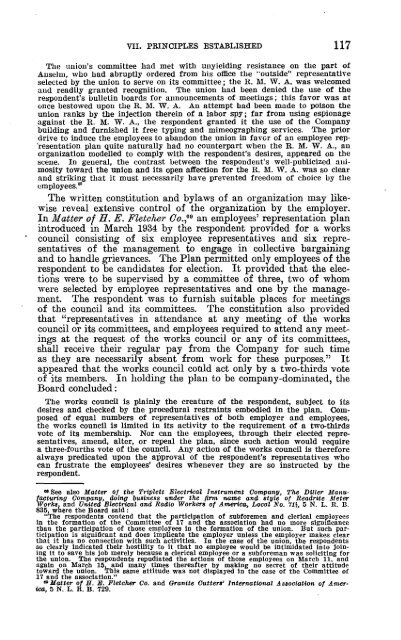NATIONAL LABOR RELATIONS BOARD
NATIONAL LABOR RELATIONS BOARD
NATIONAL LABOR RELATIONS BOARD
Create successful ePaper yourself
Turn your PDF publications into a flip-book with our unique Google optimized e-Paper software.
VII. PRINCIPLES ESTABLISHED 117<br />
The union's committee had met with unyielding resistance on the part of<br />
Ausehn, who had abruptly ordered from his office the "outside" representative<br />
selected by the union to serve on its committee; the R. M. W. A. was welcomed<br />
and readily granted recognition. The union had been denied the use of the<br />
respondent's bulletin boards for announcements of meetings; this favor was at<br />
once bestowed upon the R. M. W. A. An attempt had been made to poison the<br />
union ranks by the injection therein of a labor spy; far from using espionage<br />
against the R. M. W. A., the respondent granted it the use of the Company<br />
building and furnished it free typing and mimeographing services. The prior<br />
drive to induce the employees to abandon the union in favor of an employee representation<br />
plan quite naturally had no counterpart when the R. M. W. A., an<br />
organization modelled to comply with the respondent's desires, appeared on the<br />
scene. In general, the contrast between the respondent's well-publicized animosity<br />
toward the union and its open affection for the R. M. W. A. was so clear<br />
and striking that it must necessarily have prevented freedom of choice by the<br />
employees.<br />
The written constitution and bylaws of an organization may likewise<br />
reveal extensive control of the organization by the employer.<br />
In Matter of H. E. Fletcher Co.," an employees' representation plan<br />
introduced m March 1934 by the respondent provided for a works<br />
council consisting of six employee representatives and six representatives<br />
of the management to engage in collective bargaining<br />
and to handle grievances. The Plan permitted only employees of the<br />
respondent to be candidates for election. It provided that the elections<br />
were to be supervised by a committee of three, two of whom<br />
were selected by employee representatives and one by the management.<br />
The respondent was to furnish suitable places for meetings<br />
of the council and its committees. The constitution also provided<br />
that "representatives in attendance at any meeting of the works<br />
council or its committees, and employees required to attend any meetings<br />
at the request of the works council or any of its committees,<br />
shall receive their regular pay from the Company for such time<br />
as they are necessarily absent from work for these purposes." It<br />
appeared that the works council could act only by a two-thirds vote<br />
of its members. In holding the plan to be company-dominated, the<br />
Board concluded :<br />
The works council is plainly the creature of the respondent, subject to its<br />
desires and checked by the procedural restraints embodied in the plan. Composed<br />
of equal numbers of representatives of both employer and employees,<br />
the works council is limited in its activity to the requirement of a two-thirds<br />
vote of its membership. Nor can the employees, through their elected representatives,<br />
amend, alter, or repeal the plan, since such action would require<br />
a three-fourths vote of the council. Any action of the works council is therefore<br />
always predicated upon the approval of the respondent's representatives who<br />
can frustrate the employees' desires whenever they are so instructed by the<br />
respondent.<br />
" See also Matter of the Triplett Electrical Instrument Company, The Diller Manufacturing<br />
Company, doing business under the firm name and style of Readrite Meter<br />
Works, and United Electrical and Radio Workers of America, Local No. 714, 5 N. L. R. B.<br />
835, where the Board said :<br />
"The respondents contend that the participation of snbforemen and clerical employees<br />
in the formation of the Committee of 17 and the association had no more significance<br />
than the participation of those employees in the formation of the union. But such participation<br />
is significant and does implicate the employer unless the employer makes clear<br />
that it has no connection with such activities. In the case of the union, the respondents<br />
so dearly indicated their hostility to it that no employee would be intimidated into Joining<br />
it to save his job merely because a clerical employee or a subforeman was soliciting for<br />
the union. The respondents repudiated the actions of those employees on March 11, and<br />
again on March 15, and many times thereafter by making no secret of their attitude<br />
toward the union. This same attitude was not displayed in the case of the Committee of<br />
17 and the association."<br />
"Matter of H. E. Fletcher Co. and Granite Cutters' International Association of America,<br />
5 N. L. R. B. 729.

















